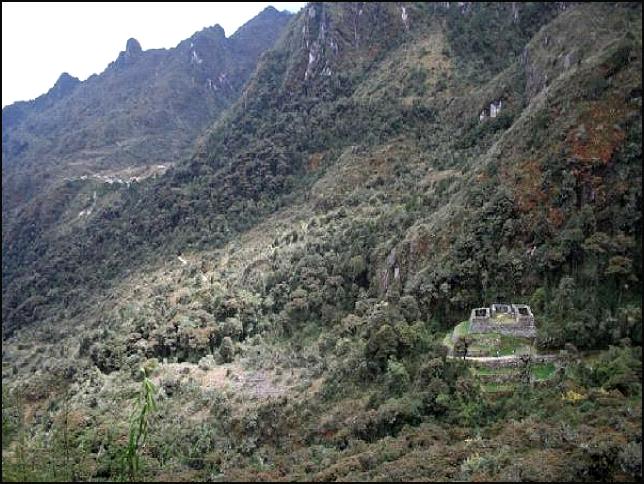The Cradle of Civilization
By
Bonnie Wayne McGuire
Contrary
to popular opinion, I don't believe civilization
began in the eastern hemisphere. The Egyptian
priests told the Greek historian, Herodotus, that
they descended from the oldest men on earth, who
lived in the west. This seems to explain why Egypt
suddenly emerged as a highly developed society
rather than slowly evolving from a primitive state.
It also lends weight to the viewpoint of those
scientists who insist that the American continent is
the launching site of civilization, because of the
tremendous amount of widely scattered fossilized
human works found here. Actually it was Plato who
pinpoints the location by saying...."the whole
region of the island lies towards the south,"
or below the Equator. If we look at a map of the
area, it becomes apparent that South America has all
the features of Plato's Atlantis. To begin with,
many scientists believe there was no land connecting
North and South America during primeval times,
therefore making the southern continent easily
reached from the Mediterranean Sea. Another
prominent feature is the magnificent Andes Mountains
(or Quechua Antis) amply sprinkled with the
ancient ruins of once wealthy villages containing
the fountains and baths so eloquently described by
Plato. The mountains form the western border of the
large oblong plain. Through the plain meanders the
largest river in the world. The Amazon has over
1,000 tributaries with a combined length of 40,000
miles. The main canal begins in the rainforests and
lakes of the Andean foothills and gathers the waters
of its many tributaries like a gluttonous brown
snake over 4,000 miles long. Every second its 208
mile wide mouth disgorges 7,500,000 cubic feet of
fresh water into the Atlantic Ocean for a distance
of 150 miles; and daily dumps enough sediment to
form a solid cube of earth equaling 500 feet
overall.
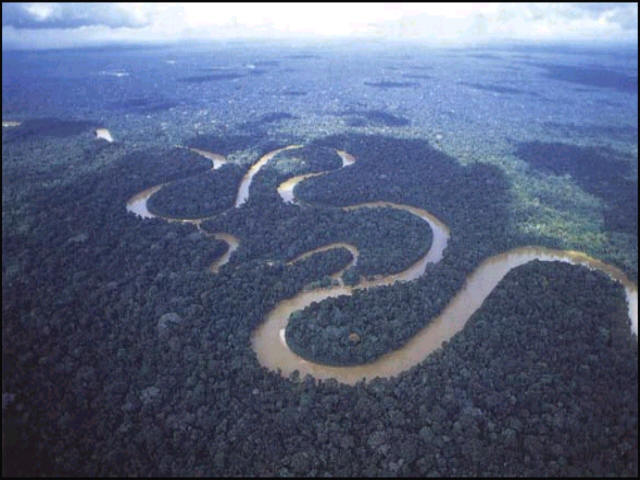
The Amazon River
The Amazon was discovered in the year 1499
by a Spanish Captain named Vicente Yanez Pinzon. It
became known as La Mar Dulce ..."The
Freshwater Sea." The name was appropriate according
to author Robin Furneaux, who says that "millions of
years before (Pinzon's) his discovery of the river,
all its lower course had formed a vast inland gulf,
which received the waters of the Amazon, Tocantins,
Xingu, Trombetas and many lesser streams. Over 1,000
miles from the mouth, above the cataracts of the
Madeira, there was yet another land-locked sea,
400,000 square miles of area on the Bolivian plains.
And far away in the Andes, at a height of 12,500
feet, there was yet a third great body of water,
larger than Lake Superior and a tenth of whose bed
is still occupied by Lake Titicaca...." Furneaux
seems to describe the three zones of sea and land
that enclosed the hill where Poseidon's Cleito
lived. One can also picture Atlantis' fertile plain
engineered with a network of streams feeding the 100
foot deep canal that encouraged a flourishing
commerce during later times. There can be little
doubt that the Amazon River and it's tributaries are
the eroded remains of Atlantean technology.
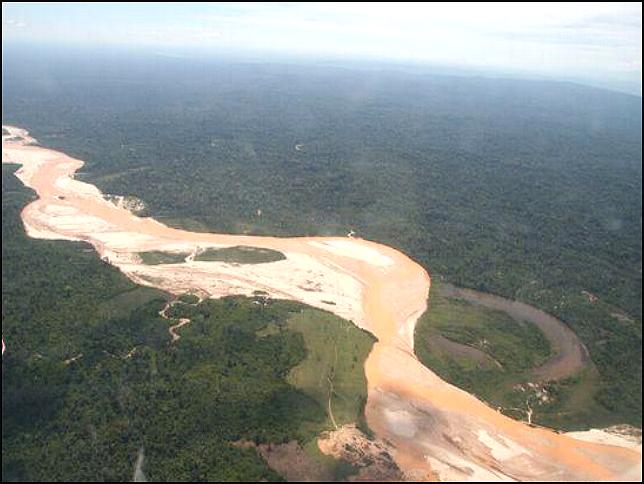
Peruvian rainforest river from Cuzco to Boca Manu.
The mountains, the plain, the rivers and the
possibility of the three inland seas are impressive,
but probably the most convincing evidence shows that
South America, like Atlantis, was submerged during a
highly civilized period oddly allotted to the Stone
Age when such advanced human ability supposedly
didn't exist. This puzzling discovery was made by
James Wilson in 1860, and earned him recognition by
the Royal Geological Society. Evidently, Wilson
traced six terraces in going up from the sea through
the province of Esmeraldas towards Quito, Ecuador.
At various points along the coast he found ancient
or fossil pottery, vessels, images and other
manufactured articles all finely made. Some were
made of gold, but most remarkable is the fact that
they were taken from a stratum of ancient surface
earth that was covered with a marine deposit six
feet deep. The geological formation where these
remains were found was as old as the drift strata of
Europe and identical with that of Guayaquil in which
the bones of the mastodons are found.
The ancient surface earth, or vegetable
mold, with the pottery, gold work and other relics
of civilization was below the sea when the marine
deposit was spread over it. The civilized land had
sunk beneath the ocean long enough to accumulate the
six feet of marine muck, and then rose again to its
former position above sea level and was reforested.
Startling as it may be, scientists placed this
civilization in South America with the time bracket
of western Europe's Old Stone Age. You will recall
that Plato said western Europe was a possession of
Atlantis. Not only did the north-western portion of
South America reveal evidence of submersion, but the
south-eastern part of the continent as well.
Scientists think the Falkland Islands are the
exposed mountain tops of land that was once above
the now shallow sea. Can you imagine the aftermath
of the cataclysm that overwhelmed Atlantis?
In the first place, the movement caused a
tremendous Tsunami wave that affected the rest of
the world (including the low lying countries along
the Mediterranean) disastrously. The towering Andes
Mountains remained above the ocean still dumping the
rainy season runoff into the shallow, muddy sea that
was the former Atlantean plain in Plato's story. "And
that is the reason why the sea in those parts is
impassable and impenetrable, because there is such a
quantity of shallow mud in the way; caused by the
subsidence of the island." Finally, after
many centuries had passed, most of the continent
rose to its former position above sea level and was
reforested. The ruined cities of the eastern
foothills were lost midst dense jungle, and
treacherous eroded rivers still carried the water
and sediment to the sea as they had done centuries
before.
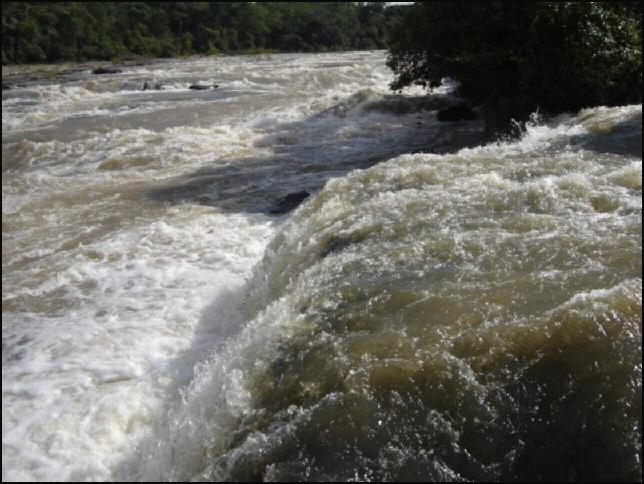
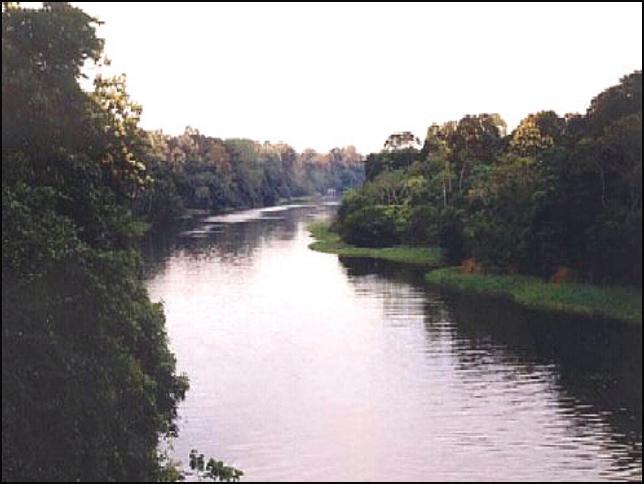
In his book "Mysteries of Ancient South
America," Harold Wilkins mentions seeing some
other ancient articles found near the area of
Wilson's discovery that bear a
resemblance to ancient Egypt. "When I was at
Santa Fe de Bogata, in Columbia....I met one Senor
Munoz, a haciendero who owns an estate on the
seashore not far from Guayaquil, Ecuador. He sent a
diver to fish up statuettes from a drowned and very
ancient city lying under water just off shore. The
diver came up with artistic statuettes of men and of
women whose hair was dressed in a very Egyptian
fashion. They had curiously long slanted eyes as you
find in frescoes in the tombs of the Pharaohs. On
their breasts were jewels carved in stone. The dead
and ancient civilization must have been, even then,
very, very old; for some of the statuettes are
pornographic...a sign that the makers are of a race
that has lapsed from a higher state of culture...As
said Munos to me: 'Senior Wilkins, it may amaze you
to hear that every race in the world is represented
in these statuettes, so incredibly ancient...The
race had seals like prisms, covered with
hieroglyphs. Also I have found ancient convex
lenses, under water there, and also reflectors. They
were made of obsidian...They must have been
scientific opticians, even astronomers."
These discoveries are fascinating, but even
more so are the rumors and legends about the lost
cities and white Indians that haunted the Brazilian
forests like ghostly whispers beckoning the careful
listener to search for their hidden treasures.
Wilkins searched for such a man of whom he wrote:
"There was, for example, Senor Bernardo da Silva
Ramos, native of Amazonas, with traits of Tapuyo
origin. He sold a collection of rare and ancient
coins in order to raise funds to embark on travels
all over North and South America, and to Africa,
Europe and the Middle East. He became keenly
interested in the ancient mysteries of Brazil...in
prehistoria, which has a literature of its
own in Brazil. Comparing the ancient inscriptions in
the lands of the "Old World" with those he found in
Central and South America, Senor Ramos filled large
folio volumes. The central authorities of Brazil
have examined those works, and expressed polite
appreciation and interest. In 1928, they voted
public money to have one volume published. Both he
and Senor Frot have found in the Matto Grosso many
inscriptions in the Phoenician, Egyptian, and even
Sumerian scripts and hieroglyphics. Senor Ramos
points out that his Indian forefathers had many
traditions of ancient date about a very ancient
culture and advanced civilization flourishing
thousands of years ago to the north and west of the
Central Highlands of Brazil.
Inca ruins at Sayac Marca
"Now, in the archives of the great
public library of Rio, which embodies the large and
valuable libraries of the old Kings of Portugal and
the emperors of Brazil, and also the records of
generations of Lusitanian viceroys, I have found a
strange manuscript written in Portuguese, and
scarcely 200 years old, but bitten by the copim and
badly mutilated in some most fascinating and
enthralling passages, which holds a secret that, in
some day not far distant, will revolutionize the
fixed and settled theories of college professors of
ethnology and archaeology, and the field museum
workers of New York, Chicago, London, Paris, Rome
and Berlin. Especially will it make hay of their
cherished theory that writing was unknown in
pre-Columbian South America. For, if the story of
strange adventures of hardy and uncultured men which
it tells, be true...and I think it is....what we
call the old world of Asia and Europe is a mere
parvenu by the side of this New world of South
America. Our professors and archaeological
historians are one day going to be forced to call in
this New World to redress the balance of the old!"
What Wilkins discovered was the manuscript
of an old bandeirista named Guimaroes regarding his
ten year wanderings through the Brazilian wilderness
(from 1743 to 1753) in search of legendary silver
mines. In the autumn of 1939 Wilkins was given a
transcript of the document through Mr. W.G. Burdett,
the American Consul-General in Rio. He then spent
many weeks translating it from the original
Portuguese. (The same document was translated by
Lady Burton in Sir Richard Burton's Explorations
of the Highlands of Brazil). Wilkins makes the
observation that out of the forty-one figures
"twenty are almost identical in form with the
letters of the Greek alphabet: kappa, upsilon, zeta,
phi, iota, gamma, beta, omicron, sigma, omega,
lambda, chi, epsilon, psi (?), theta, nu, while two
signs are remarkably like Arabic numerals."
Wilkins feels that the inscriptions on the vault
covers may be the oldest in the world. I copied the
entire translation because the two books containing
it are considered rare collectors items difficult to
find and expensive to purchase, but very interesting
to scholars of antiquity...and treasure hunters.
An observation by the bandit Guimaroes is
worth mentioning. He commented that the most heavily
ruined part of the city had "frightful crevasses
where no living things grew," almost as though
the city had been destroyed by some terrible weapon
that rendered the soil sterile to plant life
thousands of years later. On the surface it sounds
incredible that Atlantis may have been blasted into
oblivion by advanced technology comparable to our
own. Yet there are ancient writings that suggest
that is exactly what happened, and we'll study them
later. But for now, let's continue our exploration
of the ruined cities on the Amazon plain, where,
according to Wilkins and others, a highly civilized
race of handsome, intelligent men and beautiful
women with classic Greek features (of non-Grecian
origin) lived between 15,000 and 10,000 B.C. These
blond to bright red haired people lived in walled
cities....so built to hold back the mighty gulf of
the Amazon. They had gold coinage, sea-faring
vessels, aircraft, cities of glistening white stone
and marvelous plazas paved with large flagstones.
They built splendid ornate temples and mansions with
lovely fountains. They invented lenses and
reflectors like those used in astronomical
telescopes, and placed peculiar pyramids rounded on
top throughout the land bearing letters resembling
the Phoenician and Greek alphabet. Their coasts were
lit by lighthouses to guide mariners, and native
stories compare the lights to our electric bulbs.
Such a light was still in existence when the
Spanish arrived. In 1601 Barco Centenera wrote
about Gran Moxo, a city near the beginning of the
Paraguay River in the Matto Grasso in which he
described such a light: "In the middle of the
lake was an island on which were buildings of great
beauty...The mansion of the Lord, the Gran Moxo, was
built of white stone to the very roof. It had two
very high towers at its entrance, and a stairway in
the middle. At a pillar in the middle on the right
were two live lions. They crouched at its sides, in
chains of gold. On the summit of this pillar,
twenty-five feet high, was a great moon dispelling
darkness and shadows by night and day...that all
appeared bright."
A similar light was described to the famous
Colonel Fawcett by an Indian in the Matto Grosso
frontier town of Cuyaba: "These buildings in my
forests are of great age. They are loftier by far
than these, and they have doors and windows of
stone. Their interior is lit up by a great square
crystal on a pillar. So bright does it shine that it
makes the eyes blink and dazzle. It is a light that
never goes out. My forefathers knew it of old.
Always it has burnt undimmed. It is a tower-like
building which has partly fallen down, but from the
doors and windows always shines a light."
On March 23, 1773, about thirty years after
the bandeirista Guimaroes penned his discovery,
another accidental find of an old lost Brazilian
city was recorded in the archives of sao Paulo. It
was found in the unknown wilds of the Rio Pequery by
a fisherman who jumped onto a sandbank to retrieve
some wild oranges and limes. He noticed a curiously
shaped large stone that resembled a grindstone of a
mill-wheel. Nearby were the ruins of a house and an
ancient stone wall. Later he reported it to the
Commandant of the fort of Iquatemy, who went with
some men to investigate. This is what was recorded:
"This ancient city is regularly laid out, and is
of large size. It had a street that is half a league
long. The city stood on the banks of two rivers and
had a walled suburb. Moats stood between the city
and the suburb...we unearthed two more of the
strange mill-wheels, while we were making a
stockade. All round are dense forests... the old men
of the countryside have traditions that a city stood
on this spot which was called Guayra."
Probably the most impressive ruined city was
found during an expedition led by a mysterious
German doctor of science and philosophy from
Hamburg. The story was told to Harold Wilkins by a
Columbian participant who appeared to be ill with
malaria and badly emaciated. Apparently, the
explorers left Obidos, Brazil (around 1926) headed
for an unknown country in the wilderness. After many
days, they and their canoes were well up a tributary
of the Rio Negro on the way to an Amazon tributary's
headwater area. Wilson figures this expedition was
somewhere on the unknown borders of North-western
Brazil and Southern Venezuela in the upper Orinoco
country. The following is the Columbian's story:"
After we quitted the rivers, the landscape changed.
No more green hells of verdure and lofty forest
aisles where gloom and death lie waiting at the feet
of giant trees.
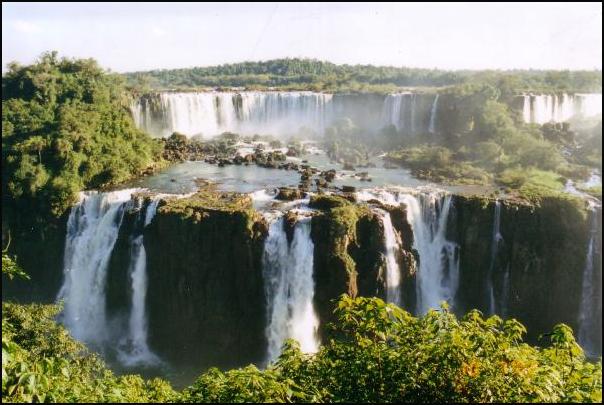
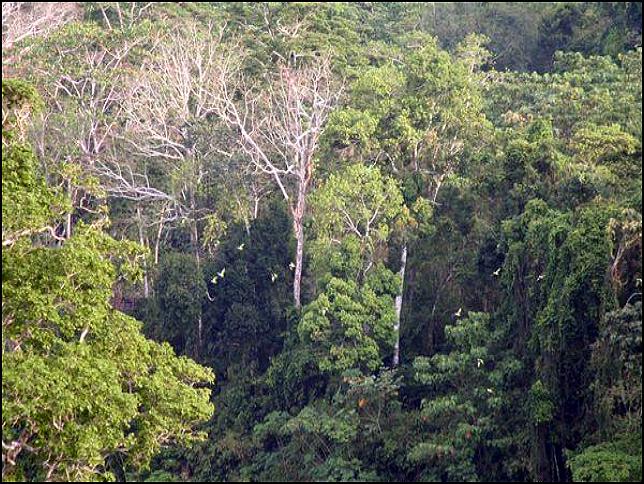
"We left that inferno verde behind, and
the country began to ascend. In a land of dry scrub,
with few brooks or springs, we left far behind us
too, the booming drums of the wild Indians we never
saw, who were signaling our passing through their
territories. I noticed, one day, that all deer and
wild animals we met fled from us at sight. It looked
as if they feared something in this mysterious
country....something unknown. this was many days
after the last vestiges of the forest had faded into
the dim, blue distance far back towards the Amazon.
Then, one day, we came on a strange, stone object
shrouded in bush and creepers. It was a stone
monument, looking like this, senor..." The Columbian
drew a diagram that was shaped like a cut through
the shorter axis of an ellipse. "Our leader, the
German doctor, said it was an ancient pyramid, and
began to look around for inscriptions, ancient
writing, or what he called hieroglyphics. Some weeks
later, I remember, we stood in a deep gorge through
which raced a tumultuous current of deep, crystal
waters, pure as though newly born from the snows of
the giant Andes. Looking up, our leader, glancing
through his Zeiss binoculars, pointed out to us,
where far up on the farther wall of the canon, an
ancient paved road ran. It cleft a wall of the upper
cliff, from which it issued, and then it came to an
abrupt end on the shelf of a precipice, as if, in a
far day, some giant earthquake had toppled the rest
of the road into boulders of the stream we stood
gazing at.
"We camped in the gorge and spent some
days exploring. A week later, we built a bridge
across the gorge, by felling a tree growing on our
side, and passed over to explore the ancient road.
It was well paved with finely masoned and squared
blocks of stone, hard as granite. We followed the
road into a long tunnel cut through the cliff walls,
and once in the sunlight, found ourselves on the
hither side of a tremendous gulf, on the dim floor
of which, far below, we faintly discerned some
strange objects like queer buildings of no sort we
had ever seen before. The paved way sent us ever
climbing up the side of the precipices and, at last,
brought us to where we could look down into another
tremendous gorge or ravine. What we saw here took
our breath away....A dead city of towering palaces,
splendid ruins, temples, with more of the carved
pillars and strange pyramids, mostly covered up with
ages of trees and jungle. There were magnificent
gardens where stood broken and aged fountains which
once must have spouted with cool waters. Below us
was an ancient wall, so high up, that trees of the
forests below barely reached its summit. We walked
further along the ancient way and came to where two
queer thin towers, one shaped like the...(virile
member)...the other had a top like a pear very
rounded at the base. Close by, at the foot of two
other walls were many small stone houses...
"Here we ambushed and caught a dwarfish
man, about four feet tall, with very red eyes. He
had a thick bushy beard that reached below his
waist, but his arm muscles were fat and big. Round
his waist was a queer leather belt with gold...pure
gold buckles of some sort. Otherwise, he was nearly
nude. We met others of these pygmy men, and all had
a most sickly sort of white skin...Yes, senor, white
as yours, and not like an Indian's or a greasers! It
was the white of old yellowed ivory...We found they
had women and they with beautiful faces, long hair,
and either red or bluish eyes. They too were nude
and their hair reached almost to their feet. The
German said they were Greek in type...ancient Greek.
They wore gold bracelets on their arms, and gold
necklets. But their strange red eyes shone like a
jaguars in the firelight. What scared them were the
reports of our guns. They'd never seen such things
before."
The Columbian told Wilkins that he and the
others explored a great pyramid temple with an
interior that blazed with gold. It sheathed the
pillars, the roofs and the walls. Strange letters
were engraved on the gold plates. Some places in the
ancient city were impossible to reach. The white men
with the red eyes appeared to be the degenerate
descendants of an ancient race. They lived on goat
meat, cheese and milk.
"In some of the pyramid temples we
entered, we saw deep, blue-veined marble altars
stained with blood, or rust. Perhaps of ancient
sacrifices, or maybe of some horrible cult of the
decayed remnants of this very ancient
civilization....But the gold, senor, not even the
Incas had so much to hide when Don Francisco Pizarro
killed the Emperor Atahualpha. High overhead, there
were alcoves or galleries actually stuffed with
splendid gold objects, vessels, chains, chalices,
insignia, and shields and plates engraved with the
strange hieroglificos. Some of these plates were
three or four inches thick...all solid gold,
tons...kilogram's...of it, senor. I took one of the
gold knives in one of the temples. Eight or ten of
them had been attached to one of the pillars. The
hilts and the blades were marvelously chased and
engraved, as by the finest goldsmiths ever known.
Looking up, in another splendid ruined stone
building, which cut into the side of a hill, I
staggered with amazement to see eight glorious suns,
of pure, shining, blazing gold from which rays were
made to shine out like stars. Groups of handsome
men, beautiful women, naked youths and maidens were
carved on the walls of this mausoleum, and over
their heads and shoulders, like the halo of nimbus
round the head of the Virgin, and the Saints or God,
shone stars or moons of pure, shining gold. Chains
hung down from the alcoves and pillars, and friezes
were inscribed with the strange signs in rows...Did
I tell you, senor, that each of the dwarfs in the
outskirts of this dead city, hiding either in
tunnels, or rooms in the rock, or the little stone
houses we saw, carried a long curved knife of pure
gold? It was not valued here. I could tell you a lot
more...especially about a queer sort of lock, like a
stick with nine rings, each ring forming one of the
queer letters or hieroglificos, which we found on a
gold chain in one of the queer pyramids. Apparently,
you turned it to form a combination to open or lock
the fetters..." The Columbian said that the
members of the expedition took all the gold they
could carry when they departed from the lost city;
and because of the heavy burden they carried, most
of the explorers were caught and killed by hostile
Indians.
The Prophet (Coricancha Inca Sun
Temple - Cusco)
Probably one of the most prestigious
expeditions organized to search for the lost cities
of the Matto Grasso was that of the Krupps of Essen,
the German armament manufacturers. During the early
part of this century they organized a large
expedition of armed men, guides, Indians and pack
animals and started their journey into the unknown
wilds of Brazil. The large group frightened the
ferocious Indians to retreat into the dense bush,
only to reveal their presence at night with showers
of poisoned arrows. During the day drums continually
beat warnings of the approaching explorers. Many
tribes of the Matto Grasso were fierce cannibals and
head hunters. There were miles of marsh and swamp,
the bleak foothills of the Chapada and barren scrub
of the Catinga that lay between the explorers and
the "White Mountains" where the legendary white
Indians and the dead cities were said to be. A wild
region that geologists believe was one of the first
areas to emerge from the primeval floods of
the Miocene Age of the Teritiary epoch....considered
to be the oldest land on earth.
Needless to say, the large Krupp expedition
had to turn back to save men and animals from
starvation in the hostile environment....a fate that
befell many Spanish explorers centuries earlier.
While the Krupp expedition was the biggest, the
most famous explorer of the Brazilian plain was
Colonel Percy Harrison Faucet. Even now, any
unlikely news about him would probably cause
newsworthy ripples. Fawcett was an imposing figure
6' 2" tall and built like a prize fighter. He
weighed a hard 200 pounds and was an athlete
obsessed with keeping fit.
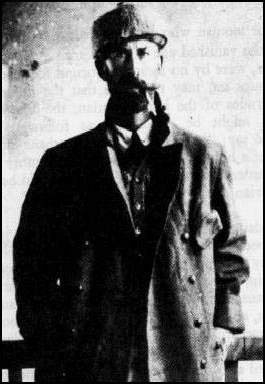
Colonel Percy Harrison
Fawcett commented, "Whether we get through, and
emerge again, or leave our bones to rot in there, one
things for certain. The answer to the enigma of Ancient
South America...and perhaps of the prehistoric
world...may be found when those old cities are located
and opened up to scientific research. That the cities
exist, I know..." Fawcett despised
alcohol and tobacco. His physical strength and stamina
was only surpassed by his iron will and contempt for any
weakness he might possess. In all his years in the
tropics he was ill only once to which he pointed with
shame. His resistance to disease was unique, since so
many other South American explorers were either thwarted
or killed by it. He was a mystic, a spiritualist, loved
the wild, unspoiled Indians, and hated the needless
slaughter of animals for sport. Next to his family, his
greatest love was the call of the wilderness and the
mysteries it hid. Like a true explorer he was happy to
return to his family, but would eventually grow restless
and long for the quest of the unknown, unmindful of the
muggy heat, squalor, insects, reptiles and formidable
Indians in his Amazon world. Fawcett's career began when
he was commissioned in the Royal Artillery in 1886. He
spent his early years in Trincomalee, Ceylon where he
married Nina, and learned to be a surveyor. During this
period he became keenly interested in archaeology and
grew accustomed to long treks into the jungle where no
one else went. One day he and a native were caught in a
storm and were forced to spend a miserable night under
the trees. Towards dawn, the storm let up and a ground
mist shrouded everything. When it lifted, Fawcett stared
in astonishment, for it was like the unveiling of an
ancient tablet of the gods. Before him was an immense
rock covered with large glyphs. He made a copy of
the inscriptions and upon his return to civilization, he
eagerly questioned a learned Sinhalese priest. The
glyphs were a form of Asoda, of the old Buddhists...in a
cipher only the ancient priests understood. This priest
thought the inscriptions recorded that an immense
treasure had been placed beneath the boulder during a
time of calamity thousands of years earlier. Later,
Fawcett made the same inquiry at the Oriental Institute
at Oxford where a renown authority told him that the
inscriptions were definitely an ancient form of Asoda,
and that he would have to visit the site in order to
take a rubbing....since the meaning of the characters
changed according to the sun's rays. Only then would he
be able to decode it. As it turned out , Fawcett could
never find the place or the boulder again.
Twenty-two years passed, during which time
Fawcett became a distinguished Colonel. In 1906 he
volunteered for boundary delineation work in
Bolivia. The Amazon frontiers of Brazil, Peru and
Bolivia had never been settled, and with the
increasing demand for rubber, it became vital to the
various provinces. Independent survey teams were
appointed, with Fawcett working for the Royal
Geographical Society engaged by the Bolivian
government. During the years 1906 to 1913, he
covered almost all the vast Amazonian frontiers of
Bolivia. He also became intensely interested in the
continent's literature and folklore of the Indians
and other explorers. Naturally, he stumbled across
the old Portugese manuscript of the bandeirista. One
can imagine his excitement when he saw the
similarity between the glyphs on the vault covers in
the dead city and those he found on the boulder in
Ceylon!
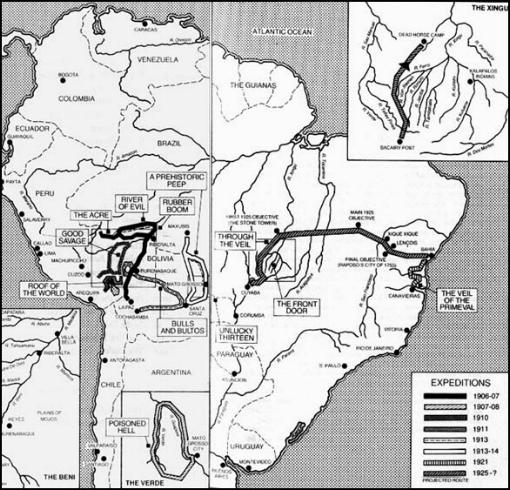
Colonel Fawcett's map.
In 1913 Lieutenant-Colonel O'Sullivan was
given a blank map by Fawcett on which he was to fill
in the route he took through that part of the Bahian
sertao leading to the ruined cities. In 1921 Fawcett
used this apparently accurate map to find them. He
wrote: "I went alone; for I know I should have
much less need to fear the Indians, who will not
attack a man alone who meets them fairly. I reached
the catinga in the serra, northwards of Bahia...and
in the midst of primeval woods, stood before me a
mass of jumbled ruins. The city had been a walled
one of ancient date. Here, wreathed in jungle and
bush there stood a giant monolith crowned by a
weather worn figure, carved in stone..."There was no
jungle which the walls of these ancient cities
served as defense. Those walls must have acted as
breakwaters in a far off day when the sea reached
far inland. The openings in their walls are arched,
filled in with masonry, and have no doors. So they
feared no attack from any jungle, but from the
encroachments of the sea. Each city was destroyed by
an earthquake...All the Indians in South America
have traditions of their ancestors being ruled by
men of a white race very advanced in the arts of
civilization."
Fawcett's observations of the cities is one
more example that two people looking at the same
object will see something entirely different
according to individual intellect and experience. He
had a remarkable knowledge of pre-historic South
America. He often quoted von Humbolt's story of
Friar Narcissus Gilbar, and talked about the
wonderful books of hieroglyphic paintings found
among the Indians in the Peruvian montana at Ucayle,
near the Amazon headwaters.
Many scholars read Plato's account of
Atlantis, but continue to search for a sunken island
in the Atlantic closer to Europe and Africa, but
Fawcett, like myself, must have noticed that Plato's
geography fits South America. He became even more
convinced after seeing the ruins and strange glyphs
that brought the legends to life. So when Rider
Haggard gave him an unusual black basalt statuette,
he took it to the British Museum for analysis. It
was clearly of South American origin, but they
declared that if it was genuine it was beyond their
experience. Naturally curious, but with no other
place to inquire, Fawcett then consulted a
psychometrist who held the statue in one hand and
with the other hand wrote that it belonged to an
advanced civilization stretching from South America
to Africa. It's people were advanced in power and
material wealth, but were morally degenerate and
given to the practice of the black arts. Violent
earthquakes shook the land, and the sea rolled over
the kingdom. The time of it's destruction occurred
long before the rise of Egypt.
Fawcett knew he was on the right track, but
needed more proof. How does one prove anything if
the leading authorities don't know anything about
it? He was fifty-seven years of age when (in 1925)
he invited his son Jack and their friend Raleigh
Rimell to accompany him to explore an area he
considered very important. Prior to their departure
from Cuyuba, he mentioned to Dr. Clark Wissler of
the New York Historical Museum that he'd been told
by a dying man about the location of a lost city in
the "White Mountains," where a strange
light burned. No one else knew about it. Wissler
said Fawcett was convinced he knew what was there
and where to look for it, but was very secretive. At
one time the Colonel had planned to use a hydroplane
to help him descend from the headwaters of one of
the rivers flowing to the ruined cities in the
Brazilian White Mountains, but he eventually
abandoned the idea. Instead, the three men decided
to leave the frontier town of Cuyaba, in the western
Matto Grosso heading north, swing north-east across
the Xingu, cross over to the Araguaia, then to the
Tocatins, reach the Sao Francisco and follow it down
to the coast. The exact course is unknown, but its
outline suggests it was one of the most dangerous
and difficult in the history of exploration.
Unfortunately, Fawcett, his son Jack, and Raleigh
Rimell faded into the jungle and disappeared
forever. But Fawcett's memory will live on to
inspire others endowed with the unquiet nature of
the true explorer to listen and follow their dreams
without fear of ridicule. His vast knowledge of the
continent's ancient history convinced him that it
was Atlantis...but the fierce and relentless
wilderness was determined to keep it's secret.
It is only a matter of time and technology
before the hidden treasures of the eastern plain are
unveiled. In 1979 an engineer and economist took the
first step to open up the interior of South America.
The Romanian born brothers Paul and Constintine
Georgecu sold a house and apartment, then spent part
of their savings to undertake what they called the
"Latin American Friendship and Integration"
expedition. Aboard their thirty-two foot boat
"Niculina" they proved that river communication in
South America is finally a possibility. They began
their journey at Margarita Island in Venezuela from
which they steamed to Buenos Aires, then to the
Casiquiare and Rio Negro and on to the Amazon in the
heart of Brazil. Next they traveled up the Madeira
which empties into the Amazon from the south, and on
into the Rio de la Plata at Buenos Aires. The
expedition's return trip to Venezuela was similar
with slight variations. Altogether they traveled
24,000 miles by river in two years. They planned
another 13,000 mile river journey from Argentina,
across the Caribbean, up the Mississippi, the Great
Lakes and on to Quebec, Canada.
The Georgecus' were mainly interested in
South America's potential for growth using river
commerce. One can see why. The Continent has thirty
percent of the worlds fresh water, one third of its
forestland, fishing cattle, agriculture, abundant
minerals and energy. But most of these riches are
untapped because nobody can get them out. The
brothers were convinced that the continent's river
network could transform the wild interior into a
land of plenty. Paul, the engineering professor at
Simon Bolivar University in Caracus, estimated that
the cost of linking all of South America through its
rivers would cost at least $50 billion....but since
the governments were mired in debt, he didn't think
that the financing for the river project would be
available some time. In 1983 Peru's President
Fernando Belaunde Terry and some other South
American presidents made part of the trip to the
Bolivar bicentennial ceremonies in Venezuela by
river aboard the "Amazonia" to show his support of
continental integration through waterways. No doubt
the future restoration of these ancient Atlantean
waterways will reveal a whole new world lying
dormant beneath the swampy jungles of this forgotten
prehistoric land.
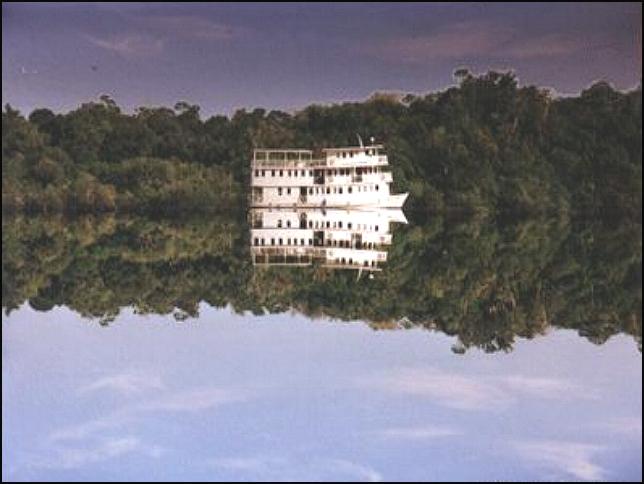
|
